Cisco Intelligent Peering Solution Overview
Available Languages
Bias-Free Language
The documentation set for this product strives to use bias-free language. For the purposes of this documentation set, bias-free is defined as language that does not imply discrimination based on age, disability, gender, racial identity, ethnic identity, sexual orientation, socioeconomic status, and intersectionality. Exceptions may be present in the documentation due to language that is hardcoded in the user interfaces of the product software, language used based on RFP documentation, or language that is used by a referenced third-party product. Learn more about how Cisco is using Inclusive Language.
Are exponential traffic growth and dynamic cloud service traffic patterns impacting your network and the services it delivers?
According to the Cisco® Virtual Networking Index (VNI), video traffic is projected to have a Compounded Annual Growth Rate (CAGR) of 29 percent from 2017 to 2022 and will make up 82 percent of global IP traffic. This traffic growth is driven by 28.5 billion networked devices that need access to latency-sensitive streaming video or cloud hosted services such as Amazon Web Services or Microsoft Azure.
Cisco can help minimize your costs through improved automation, distributed peering, and traffic optimization. Our solutions for intelligent peering combine Cisco Network Convergence System (NCS) 5500 Series routers with automation tools such as the Cisco Crosswork™ suite and orchestration tools such as Cisco Evolved Programmable Network Manager (EPN-M) and Cisco Network Services Orchestrator (NSO).
Simplicity, scalability, and resiliency
● Segment routing simplifies design
● Topology- Independent Loop-Free Alternate (TI-LFA) offers resiliency
Cost optimization
● Reduces transport costs
● Traffic engineering optimizes network utilization
● Automation and low-power systems reduce OpEx
● Flexible consumption model reduces capital outlay
Trust and security
● Anti-tampering hardware and software
● BGP monitoring with BGP route hijacking detection
● Netflow and BGP Flowspec enable earlier DDoS attack detection, which protects services
The need to maintain quality of service
The continued growth in latency-sensitive traffic and the move to cloud services increases the need for optimized traffic flows to eliminate congestion for high-priority traffic. Network providers must consider multiple strategies to minimize costs while maintaining high levels of service. An important consideration is how to move the data to their users as quickly as possible while simultaneously removing additional traffic from the network to avoid congestion. This approach will help reduce unnecessary capacity consumption and long-haul costs while maintaining Quality of Service (QoS) for customers.
To minimize costs, network providers need to consider solutions that will simplify network operations, bring content closer to the consumer, and build their networks with low operating cost devices and infrastructure.
Simplification to reduce costs
Network simplification can reduce costs and have a positive impact on Operational Expenses (OpEx) by reducing the time your engineers spend working on the network to fix routing issues, studying consumption data, and trying to anticipate capacity growth needs. By deploying Segment Routing (SR), network providers can eliminate complex, stateful control plane protocols, which makes the network easier to manage. Engineers can spend less time fixing network problems and more time on revenue-generating tasks. Enabling high-fidelity telemetry data capture and YANG modeling will help guide your engineering to focus on near real time consumption patterns allowing them to anticipate a congestion event before it happens improving overall performance.
The goal of distributed peering is to reduce the amount of traffic that is backhauled to centralized aggregation exchange points. Reducing the distance and hops across a network through distributed peering improves performance and the quality of service for customers. It also lowers the transport costs and capital expenditures for the service provider because their existing routes can be maintained longer before needing capacity upgrades.
Network orchestration to improve performance
Combining these local peering connections with a network orchestrator can further improve the network’s performance. By automating routing changes to balance the traffic flows, you can maintain Service-Level Agreement (SLA) performance standards. Whether you use Cisco automation tools such as the Cisco Crosswork™ suite, or a third-party orchestration tool, automating device onboarding, fault route policies, and network configuration updates can lower your operating expenses. Products such as Cisco Evolved Programmable Network Manager (EPN-M) and Cisco Network Services Orchestrator (NSO) can reduce human error in implementing network changes, which will reduce one of the leading causes of network failures.
Automation within the network can also improve the resiliency of the network. Service providers can use Software Defined Networking (SDN) capabilities to build their networks based on fabric architectures that offer scalability, topological regularity, and operational simplicity. The modular properties of fabric architectures also have inherent operational cost benefits because network availability isn’t lost with any link or node failure. The fabric is designed to use alternate paths to accommodate load shifting during a node failure. Repairs are simpler. No maintenance window is necessary to fix the failure. Using this model, operators program out a node, apply software updates and configuration changes, verify the system state to ensure that updates are correctly deployed, and program the node back in at any time without disrupting traffic.

The Cisco NCS 5500 Series router offers high-density combined with low power consumption. It comes in small and large form factors, which makes it suitable for low- or high-scale deployments. The NCS 5500 uses the Cisco IOS-XR network operating system, which has been deployed by leading Tier-1 providers and large-scale enterprises because of its reliable routing protocols and rich feature set. Like other Cisco platforms, the NCS 5500 is designed with the Cisco Trust Anchor module. Cisco Trust Anchor and a secure-boot check of signed images help ensure that the code running on Cisco hardware platforms is authentic and unmodified. It establishes a hardware-level root of trust and a unique device identity for the system to build on. The native run-time protection that is built into IOS-XR makes the NCS 5500 a key component of a network that can be trusted.
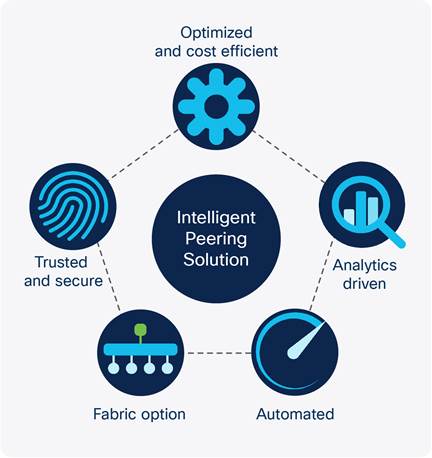
Although Cisco offers other options, the NCS 5500 router series is optimized for peering.
The NCS 5500 is powered by Cisco IOS-XR software, which is a modular and distributed network operating system for service provider networks. Cisco IOS-XR creates a highly available, highly secure routing platform while delivering segment routing, telemetry, and routing features.
The NCS 5500 Series router offers high-density combined with low power consumption. It comes in small and large form factors, which makes it suitable for low- or high-scale deployments like peering connections.
NCS 5500 router series:
● Modular systems - NCS 5516, NCS 5508, and NCS 5504
● Fixed systems - NCS 5501, NCS 5502, and NCS 55A2
For more information, see the NCS 5500 Series data sheet.
Cisco Crosswork Network Insights helps you monitor the routing health of your network by providing network visualization, rich analysis, alarms, and actionable network events. The product can help you detect route high-jacking, route leaks, and man-in-the-middle attacks. For more information, see the Cisco Network Services Orchestrator data sheet.
Our networking services help you outline a strategy to achieve your desired business outcomes. We can help you navigate evolving technology and digital transformations, prepare your business for emerging trends, and address risks and compliance. Using our expertise, tools, and methodologies, we can help you improve efficiency and build an agile network for the future.
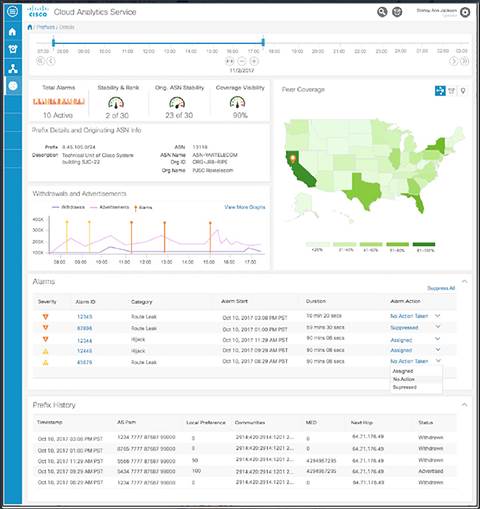
Cisco Evolved Programmable Network Manager is designed for element and network management systems. It provides simplified, converged, end-to-end lifecycle management for carrier-grade networks of all sizes. Businesses can improve agility and operational efficiencies through automated device operations, fast provisioning, and proactive assurance. For more information, visit Cisco Evolved Programmable Network Manager.
Cisco WAN Automation Engine helps customers utilize their network more efficiently and can facilitate new services and revenue opportunities. For more information, visit Cisco WAN Automation Engine.
Cisco peering solutions can be deployed in many different situations. For more details, read the Cisco Peering Fabric blog.
Traditional IXP peering
Peering fabric extensions
These extensions are ideal for when multiple third-party facilities are close by. Connection to some of the facilities may be done with grey optics or CFP2-DCO, which are available on the NCS 5500.
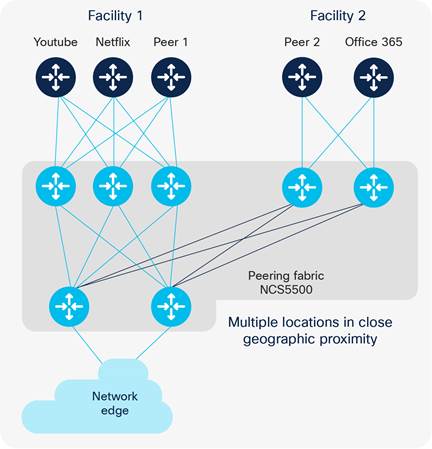
Extensions to connect facilities
Localized metro peering and content delivery
With a local peering facility, providers can bring content closer to the customer. At this facility, providers may offer their own video service as well as peer with OTT video services.
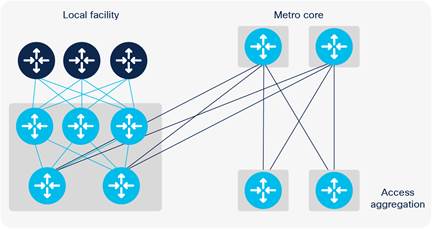
Localized metro peering
Express peering fabric
Much like local peering, express peering fabric offers a direct connection to the access layer. This option helps offload OTT traffic, which provides better performance for users. These connections can be done with a small transport box, such as the Cisco NCS 1000, or with CFP2-DCO optics.
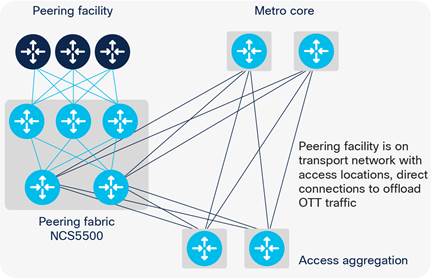
Express peering fabric
Data Center edge peering
This option moves customers and virtualized applications closer to one another. In this configuration, the peering fabric is connected directly to the data center spine.
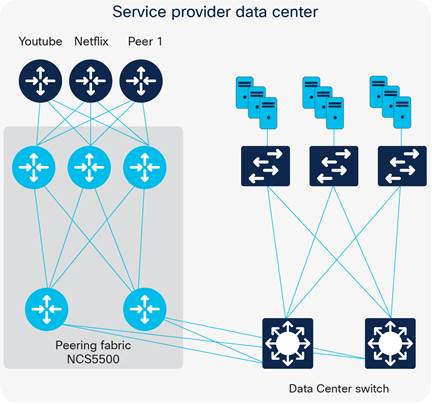
Flexible payment solutions to help you achieve your objectives
Cisco Capital makes it easier to get the right technology to achieve your objectives, enable business transformation and help you stay competitive. We can help you reduce the total cost of ownership, conserve capital, and accelerate growth. In more than 100 countries, our flexible payment solutions can help you acquire hardware, software, services and complementary third-party equipment in easy, predictable payments. Learn more.
Do you need help building a secure, scalable peering solution? For additional information, contact your Cisco sales representative or Cisco authorized channel partner.